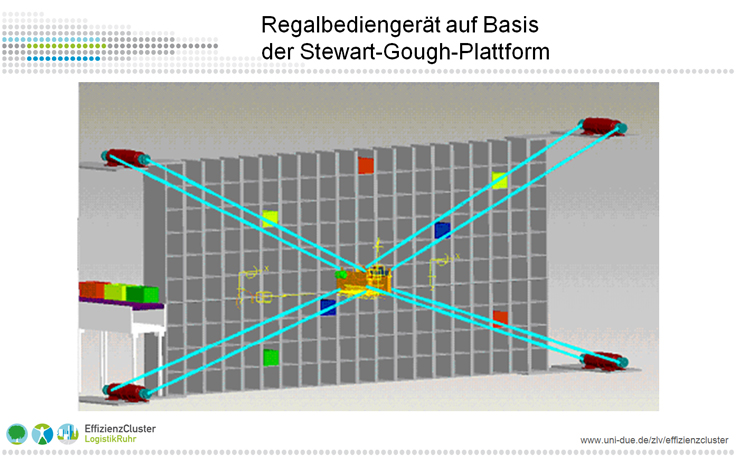Rack Feeder based on the Stewart-Gough-Platform
Project description
The increase of the automation degree in intralogistics systems in the past makes innovative approaches essential, because customer demands and requirements require a higher dynamic in the processes. As part of the ongoing climate change debate a further main focus will be on energy-saving solutions. With the development of a fast rack feeder for boxes these aims can be better achieved.
The basic idea behind the new rack feeder is to minimize the load to be moved by using a cable based Stewart-Gough platform. By using mechantronical development methods an innovative system will be implemented in this project, that can convey loads fast and energy efficient by means of computerized cable winches with state-of-the-art control methods.
Thereby the classical rack feeder is replaced with a platform that is affixed to up to eight pre-stressed cables. The simple mechanical construction results in very low mass weights which have to be moved. In cojunction with an efficient real-time control storing and removal processes from the various storage areas will be accelerated and more flexible.
This transport system is connected to existing intra-logistic systems. Thereby a specialized control system is used, which can exploit the full potential of this new technology, while ensuring a compatibility to the established intra-logistics systems.
The expected potentials of the Stewart-Gough platform used in intra-logistics are manifold: they are in the shortened cycle times, higher maximum speed, higher acceleration and optimized warehouse dimension.
Reduced costs for investment, maintenance, support and depreciation are also expected. A further thrust of automation within the intra-logistics and new fields of application in logistics systems are potentially realizable with the development of the new rack feeder. In direct comparison to traditional rack feeders the parameters of the Stewart-Gough platform for all four cost areas are lower. The investment costs can be reduced even up to the half of the investment costs of traditional rack feeders.
Overall the Stewart-Gough platform is the technological leap among the rack feeders. Expected beneficial effects are:
- It is easier to scale for the different load ranges.
- It has to move less mass.
- More precise positioning and higher storage utilization at any warehouse configuration.
Also, because of redundancies, both higher availability and easy integration into existing intra-logistic systems is guaranteed. Furthermore it can show a higher energy efficiency by lower energy consumption. There will be new business segments, such as new maintenance services and new storage system integrators.
On the scientific field the research project is operated by two disciplines, mechatronics and logistics, under consideration of their own priorities:
- From the view of mechatronics research it applies to establish a control engineered control concept to identify the configuration of motors and ways for the optimization of working space as well as to reach a minimization of weight.
- For research in logistics the identification of construction parameters, the determination of performance parameters, the system configuration for the different fields of application as well as the combination with intralogistics systems are of outstanding interest.
By developing a rack feeder based on the Stewart-Gough-Platform performance gains as well as cost savings are realistically achievable. The cheaper, novel rack feeders can thus be used in mainly small and medium-sized companies of intralogistics. These companies will also appreciate the optional configurability of the storage space and the spatial flexiblity. Furthermore the necessary software developments will be taken over by powerful and innovative companies.

